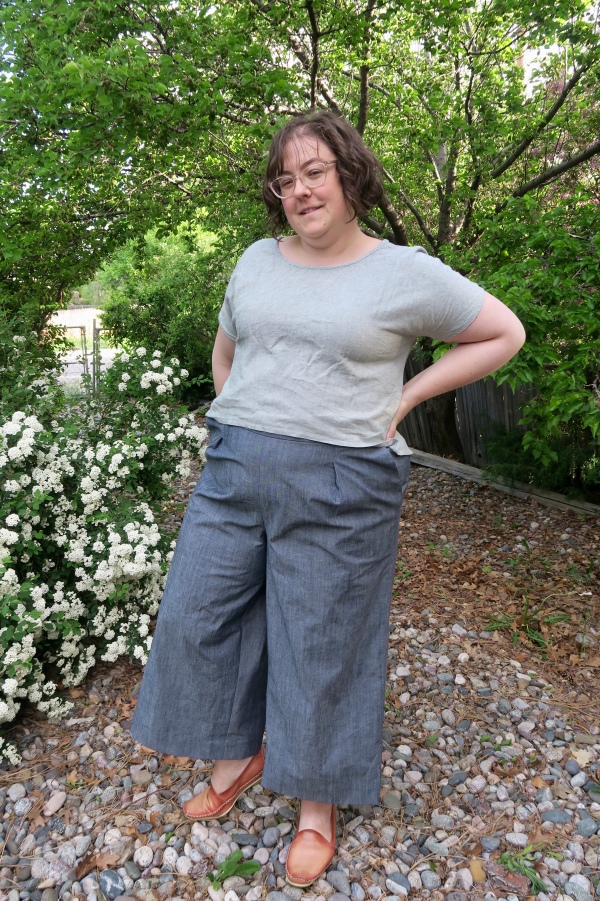
A major focus of my sewing projects over the past couple of years has been trying to sort out WHAT THE HELL is going on my pants/trousers and why they don’t fit my body. It’s been met with mixed results. I’ve been working on my jeans patterns for quite some time (and owe you all another post on that). The Peppermint Magazine Wide Leg Pants fit shockingly well out of the “envelope” and the Decades of Style Opehlia Overalls were easily fixed with one major adjustment.
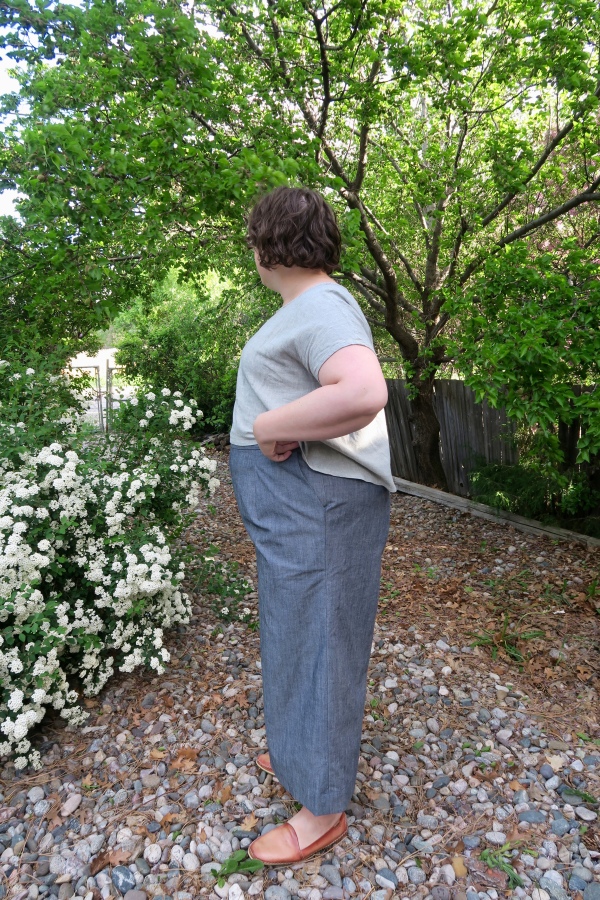
I was beginning to think I was getting this pants fitting thing down, but as they say, pride comes before the fall. And the fall was the Flint Pants from Megan Nielsen. For some reason I really struggled with these. I am happy with the outcome, though the stiff chambray I used still highlights all sorts of issues, especially in the front. I’ve seen these look beautiful in more drape fabrics, so I am cursing myself for my fabric choice. I do hope it softens up with multiple washings and I may try some of the tricks suggest to me like washing them him vinegar or coke.

I am going to walk you through all of my fit alterations, mostly so that I have this to refer back to in the future. I found this to be a helpful exercise in understanding how my alterations based on pinning and fitting affected the flat pattern. Most of the modifications were made to the back pattern piece, so I am only showing that here. In addition to the fit alterations, I changed the back waistband to have internal elastic and as part of the alteration, removed the back darts. I took pictures of that process so I will try to share that at some point as well. On to the fitting!
Step 1:

I started with the size 26 and based on past pants fitting nightmares, I added 1″ to the crotch curve on the back thigh. In hindsight, I should have done the same to the front, as this pattern is very straight through the inner thigh. I also removed the dart extension since I was inserting elastic in the back waistband and not using the dart. The black is the original pattern and the red is my initial alteration.
Step 2:

As a result of the initial fitting, I first scooped out the back crotch (shown in orange). I never know what to think about this adjustment, as it is often suggested to me but never totally fixes my problems. I think one thing it does achieve is to remove some of the width from the back low hip, as the fullest part of my bum is about 3″ below my hips, and not 8″ as I have been told most patterns are drafted for. There is some puckering under the bum, but I had not yet removed the excess fabric in the curve, so it was pulling. You can see the pants are hanging better overall, but things are still not great.
Step 3:

I removed 1.25 inches from the back waist at the center back (shown in yellow), tapering to nothing at the side seams, and then added the waistband. The internal elastic is just pinned here, so its not laying flat. I also removed the excess fabric that was causing the puckering in the previous photos, though it still looks like it is pulling. The strange thing is that it isn’t even touching my body at this point, even though it looks like it is? IDK! PANTS! I’m not sure this step helped much, but I wanted to give it a try since it had worked so well with my Ophelia Overalls. I do think the pants are hanging a bit straighter after this step, but since I forgot to take a side photo, we will never know.
Step 4:
For the final fitting step, I finished the waistband and elastic off, then started experimenting with taking in the side seams. Above, I have basted in the outer side seams on just one side, my outstretched arm indicated the side that was altered. You can see that this started to make a big difference in both the balance of the pants, and in preventing them from looking like total clown pants because of the width. In the back shot, I think you can nearly envision where my lack of fullness in the low hip is causing the pants to collapse inwards, whereas when I’ve removed that width at the side seam, they are hanging a bit better. Below (in green) is the final width alteration I settled on after a lot of basting and ripping of seams.

I slimmed down the legs a total of 5″ each, 1.5″ at each side seam starting just below the high hip, and 1″ on the inner thigh starting 8″ below the crotch point (essentially just below where my thighs stop touching). I also used a trouser hook instead of a second button on the waistband to add a bit more support to the waistband. The result is the photos shown at the beginning of this post and below.
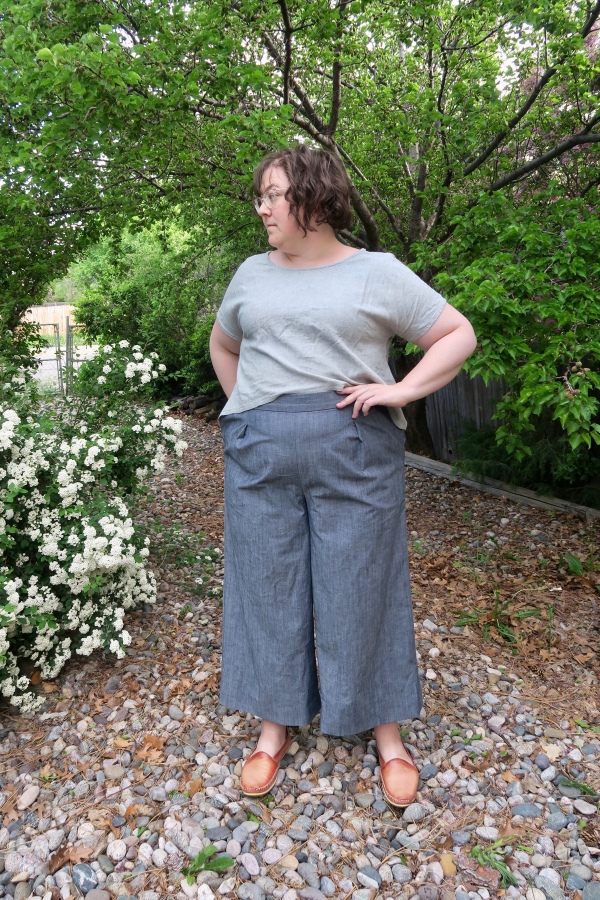

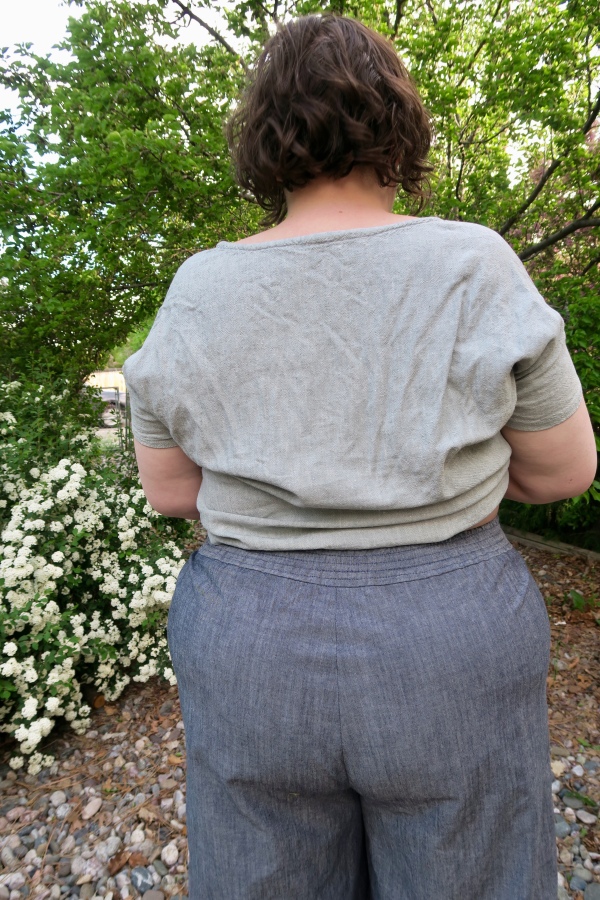


So what have I learned? To be honest, not much during this fitting process, but a lot about the open source program Inkscape, which I used to make these illustrations. On the fitting front, it really felt like two steps back. I think the final pants are OK, but the stiff chambray isn’t doing me any favors. I think the addition of length to the inner thigh as well as the swayback adjustment, in essence, resulted in a tilted pelvis adjustment, which is something I have been wanting to experiment with. The balance/drape of most wide leg pants patterns does not work with my body, and I’m still trying to sort out why and how to fix it. I would really like to set aside some time to workout these issues, and hopefully this is a start, but next time I need to try a pattern with less design details. I have a couple in mind, so stay tuned. And if you have an insights, please let me know below!

Just the Facts:
Pattern: Megan Nielsen Patterns Flint Curve
Current Measurements: Bust: 45″, Waist 42″, Hip 53″
Size: 26 with all the alterations listed above
Fabric/Notions: Chambray from Imagine Gnats, no longer available
Disclaimer: This pattern was provided in exchange for a review on the Curvy Sewing Collective blog. Be sure to check it out if you would like to see this pattern on three other ladies!




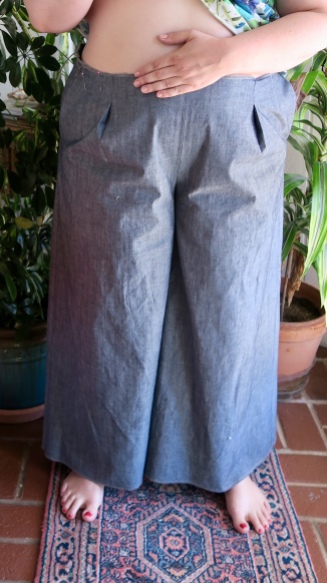





As someone who has many of the same issues, and has fought the pants battle for more than 20 years, I think you might want to scoop out the back crotch curve slightly more. It looks like you still have a slight wedgie, and I know that helps. Good luck with this!
LikeLike
Thanks Lynda! I have tried it in the past with mixed results.
LikeLike
I have all these same problems (in a size 20). The dawn jeans were a catastophe. I start thinking that I have to make a sloper for my own body. It is almost what you do. It makes no sense (imho) to try and change THAT much on an existing pattern and still have a non pleasing result. It is so so frustrating and I gave up. And the next morning, I still buy all those promising patterns to end with the same result. i have on top of it also very flat and low derriere 😱.
LikeLike
Thanks for sharing, Muriel. I was considering her new ash jeans pattern, but I think you are right, it will be an exercise in frustration. I might as well keep altering my Ames jeans, which are now fairly close to where I would like them to be.
LikeLike
Also, Megan. If you are interested in drafting your own sloper, I can highly recommend Don McCunn’s How to Make Sewing Patterns. It is easy and fairly quick to do IMO. Frequently the book can be found in the library.
LikeLike
Thank you so much! I tried the craftsy class and I gave up because I could tell it wasn’t really going to address by specific issues. I will look for that book. I would really like a slipper.
LikeLike
I suggest making a crotch curve template using the book Fitting and Pattern Alteration by Liechty, Pottberg, and Rashband. I found making a template and getting the curve right to be the most significant improvement in pants fitting for my body, my template looks completely different than the pattern. The book is dense but has so much helpful information.
LikeLike
Thank you so much! I will look for that book. A crotch curve template sounds amazing!
LikeLike
Oh I have that book. And on top of it, I brought it with me on my holiday. Can you please refer to a page number because there is so much in it!! Thank you so much.
LikeLike
I’m so glad we are having this discussion!!! I worked with that section of that book for weeks. It got me in the ballpark on crotch length, crotch depth, & width of my crotch extension but it didn’t work for me to shape the crotch curve to my body. I ended up with a strange hook shape (low booty) that didn’t wear well. i concluded that this shaping technique must work best when the amount of scooping is minimal. My scoop was pretty significant. Am I missing something? I’d love to know if you had a different experience.
LikeLike
I am also sort of lost when it comes to the scoop! I’ve tried more, less, different angles, and I can’t seem to come to any conclusion!
LikeLike
I think the first set of pics show close to a really, really good fit. I rely heavily on drawn level and grain lines to help me figure out where I need to alter my muslins so I can’t be sure but it looks like adding a little to the front crotch extension and adding a (slash & spread) wedge to the center front would have worked a charm. I left a comment for you on the curvy sewing collective post about these pants on how that wedge alteration has cured my pants fitting woes. You’ve got to make room for the tummy and waist without adding to the hips.
LikeLike
Thank you so much! I do think I need more room in the front, which isn’t something I normally need so I didn’t add it preemptively and then it was too late! I have another wide leg pants pattern to try and and I am hoping to find the time to muslin and I am making a not to myself to remember to add the level and grain lines. Thank you!!
LikeLike
What I’m loving is the ability to use a properly fitted pants pattern to check against a new pattern & seeing the alterations needed. If I match the hip level lines I can judge where the new pants will hit at my waist. I can see how wide the legs will be in comparison & walk the crotch curves to see if they are long enough. I’m was so tired of starting from scratch every time.
LikeLiked by 1 person
Those diagrams are actually very helpful. The changes that you made on these seem to be right on target, in my opinion. Contrasting the first and last set of pictures, these pants fit really well by the end, especially the drape of the legs and the fit through the seat. It’s so easy to get bogged down in pants fitting, but I would call these a win — even if it was frustrating. My pants-fitting woes are only slightly different from yours — and I have never gotten pants to fit perfectly. I always get to “good enough” and give up! 😉
LikeLike
I am a total fan of good enough- I have to remind myself that no one else is examining my pants like I am! I think I either need to develop a sloper (and then figure out how to use it) or just nail down my pattern alterations that I need to make to every pattern. I am just tired of every pattern being a new experiment (especially when I mostly skip the muslin process).
LikeLike
Great post! Thanks for all the information you included! Very helpful for when I get around to making Meagen’s pants! 😉
LikeLike
Thanks for showing your alterations. I’m a similar size and shape as you so this information is really helpful. I think your finished pants are a great improvement on the original so well done! I’ve given up on pants and jeans at the moment, I will revisit them at a later date. I’m working on fitting my bodice and have come across some great video tutorials from in house patterns studio. They have some pant fitting tutorials that might be worth a look!
LikeLike
Thanks Amanda! I hope this might be somewhat helpful when you revisit pants, though I must say this was a fairly strange pattern. I will try to do the same for my Ames jeans, that might be more helpful!
LikeLike
Alexandra is such a sweet and helpful person and she also works with that same book that has been mentioned above. She says somewhere in her many videos that you cannot scoop the back crotch curve a lot because of pattern distortion and I have that same experience. But nowhere I find THE solution for low fat derriere.
LikeLike
Hi Meg,
What a great (and super helpful) review. I’m a visual brain gal and your pattern alt.’s plus photos combo really lit up the ol’ light bulb. 😃
I wish my mum was still around to quiz about a technique I saw her use ages ago. She hand stitched a red thread on grain at about the same place you would have the dart (back view) down to just below the butt cheek. It really helped show the results of each adjustment.
By the way, old family lore refers to the lack of lower hip width as “ScandaHOOvian seat cushion” !?! LOL I’m said to closely resemble my maternal grandmother (she passed before I was born) and my mum was a dead ringer for her M. grandmother. That takes us back to mid. 1800. Difficult to prove since there are no butt shots of any of those ladies! I do think the sense of humor must have been passed along.
About good enough, ” it’ll never show on a running horse!” Is the phrase passed down for the imperfections we obsess over. 😄
Hope some of this at least made you smile or was helpful. Thanks for taking the time to share all your hard work. I’m inspired to think maybe someday I too will have pants that fit well. 😊
Yours,
Merry
LikeLike
I have just made my first set of trousers and ended up with pretty much identical fit issues, except I’m a 30 so they’re more pronounced. I did feel a bit lost with how many adjustments might be needed, especially when I’m not 100% sure what the issue is but this post was really useful and has made me decide to go back, break it down and try fixing them 1 at a time. Does it get any easier? 😀
LikeLike
Hi Sarah! I can remember exactly what I said in this post- but I don’t think the fit is very good on these in the larger plus sizes! It’s not you, it’s the pattern!! Unless you are really dedicated to this specific style, I would suggest trying a different pattern like maybe the Muna and Broad Glebe pants, which are also a wide leg pant, but the plus size drafting seems to work for a lot more people. If you do want to work on the flint, in hindsight, I would suggest starting by adding a massive amount of length to the back crotch curve. Also, I do offer virtual sewing/fitting classes if you are interested, info is under the “teaching” tab at the top of my page. Good luck!
LikeLike